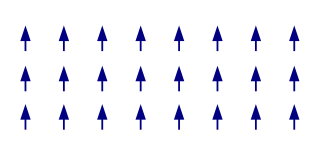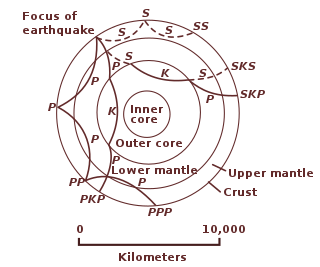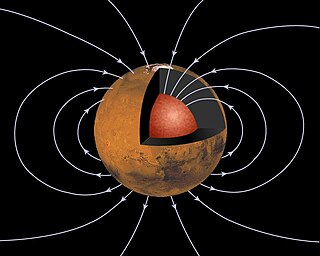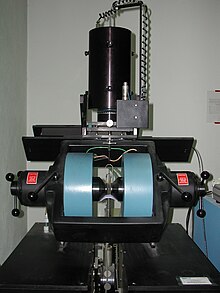
Ferromagnetism is a property of certain materials that results in a significant, observable magnetic permeability, and in many cases, a significant magnetic coercivity, allowing the material to form a permanent magnet. Ferromagnetic materials are familiar metals that are noticeably attracted to a magnet, a consequence of their substantial magnetic permeability. Magnetic permeability describes the induced magnetization of a material due to the presence of an external magnetic field. This temporarily induced magnetization, for example, inside a steel plate, accounts for its attraction to the permanent magnet. Whether or not that steel plate acquires a permanent magnetization itself depends not only on the strength of the applied field but on the so-called coercivity of the ferromagnetic material, which can vary greatly.

Magnetism is the class of physical attributes that occur through a magnetic field, which allows objects to attract or repel each other. Because both electric currents and magnetic moments of elementary particles give rise to a magnetic field, magnetism is one of two aspects of electromagnetism.

Superparamagnetism is a form of magnetism which appears in small ferromagnetic or ferrimagnetic nanoparticles. In sufficiently small nanoparticles, magnetization can randomly flip direction under the influence of temperature. The typical time between two flips is called the Néel relaxation time. In the absence of an external magnetic field, when the time used to measure the magnetization of the nanoparticles is much longer than the Néel relaxation time, their magnetization appears to be in average zero; they are said to be in the superparamagnetic state. In this state, an external magnetic field is able to magnetize the nanoparticles, similarly to a paramagnet. However, their magnetic susceptibility is much larger than that of paramagnets.

In materials that exhibit antiferromagnetism, the magnetic moments of atoms or molecules, usually related to the spins of electrons, align in a regular pattern with neighboring spins pointing in opposite directions. This is, like ferromagnetism and ferrimagnetism, a manifestation of ordered magnetism. The phenomenon of antiferromagnetism was first introduced by Lev Landau in 1933.

In physics and materials science, the Curie temperature (TC), or Curie point, is the temperature above which certain materials lose their permanent magnetic properties, which can (in most cases) be replaced by induced magnetism. The Curie temperature is named after Pierre Curie, who showed that magnetism was lost at a critical temperature.

A ferrimagnetic material is a material that has populations of atoms with opposing magnetic moments, as in antiferromagnetism, but these moments are unequal in magnitude so a spontaneous magnetization remains. This can for example occur when the populations consist of different atoms or ions (such as Fe2+ and Fe3+).
Remanence or remanent magnetization or residual magnetism is the magnetization left behind in a ferromagnetic material after an external magnetic field is removed. Colloquially, when a magnet is "magnetized", it has remanence. The remanence of magnetic materials provides the magnetic memory in magnetic storage devices, and is used as a source of information on the past Earth's magnetic field in paleomagnetism. The word remanence is from remanent + -ence, meaning "that which remains".

Paleomagnetism is the study of magnetic fields recorded in rocks, sediment, or archeological materials. Geophysicists who specialize in paleomagnetism are called paleomagnetists.
Archaeomagnetic dating is the study and interpretation of the signatures of the Earth's magnetic field at past times recorded in archaeological materials. These paleomagnetic signatures are fixed when ferromagnetic materials such as magnetite cool below the Curie point, freezing the magnetic moment of the material in the direction of the local magnetic field at that time. The direction and magnitude of the magnetic field of the Earth at a particular location varies with time, and can be used to constrain the age of materials. In conjunction with techniques such as radiometric dating, the technique can be used to construct and calibrate the geomagnetic polarity time scale. This is one of the dating methodologies used for sites within the last 10,000 years. The method was conceived by E. Thellier in the 1930s and the increased sensitivity of SQUID magnetometers has greatly promoted its use.

In geophysics, a magnetic anomaly is a local variation in the Earth's magnetic field resulting from variations in the chemistry or magnetism of the rocks. Mapping of variation over an area is valuable in detecting structures obscured by overlying material. The magnetic variation in successive bands of ocean floor parallel with mid-ocean ridges was important evidence for seafloor spreading, a concept central to the theory of plate tectonics.
Natural remanent magnetization (NRM) is the permanent magnetism of a rock or sediment. This preserves a record of the Earth's magnetic field at the time the mineral was laid down as sediment or crystallized in magma and also the tectonic movement of the rock over millions of years from its original position. Natural remanent magnetization forms the basis of paleomagnetism and magnetostratigraphy.

The term magnetic structure of a material pertains to the ordered arrangement of magnetic spins, typically within an ordered crystallographic lattice. Its study is a branch of solid-state physics.
Viscous remanent magnetization, also known as viscous magnetization, is remanence that is acquired by ferromagnetic materials by sitting in a magnetic field for some time. The natural remanent magnetization of an igneous rock can be altered by this process. This is generally an unwanted component and some form of stepwise demagnetization must be used to remove it.
Plate reconstruction is the process of reconstructing the positions of tectonic plates relative to each other or to other reference frames, such as the Earth's magnetic field or groups of hotspots, in the geological past. This helps determine the shape and make-up of ancient supercontinents and provides a basis for paleogeographic reconstructions.
Magnetic mineralogy is the study of the magnetic properties of minerals. The contribution of a mineral to the total magnetism of a rock depends strongly on the type of magnetic order or disorder. Magnetically disordered minerals contribute a weak magnetism and have no remanence. The more important minerals for rock magnetism are the minerals that can be magnetically ordered, at least at some temperatures. These are the ferromagnets, ferrimagnets and certain kinds of antiferromagnets. These minerals have a much stronger response to the field and can have a remanence.
Environmental magnetism is the study of magnetism as it relates to the effects of climate, sediment transport, pollution and other environmental influences on magnetic minerals. It makes use of techniques from rock magnetism and magnetic mineralogy. The magnetic properties of minerals are used as proxies for environmental change in applications such as paleoclimate, paleoceanography, studies of the provenance of sediments, pollution and archeology. The main advantages of using magnetic measurements are that magnetic minerals are almost ubiquitous and magnetic measurements are quick and non-invasive.
When an igneous rock cools, it acquires a thermoremanent magnetization (TRM) from the Earth's field. TRM can be much larger than it would be if exposed to the same field at room temperature. This remanence can also be very stable, lasting without significant change for millions of years. TRM is the main reason that paleomagnetists are able to deduce the direction and magnitude of the ancient Earth's field.

The following outline is provided as an overview of and topical guide to geophysics:
In geomagnetism, paleointensity is the study of changes in the strength of the geomagnetic field over Earth's history. Émile and Odette Thellier were the first to make laboratory measurements to determine the strength of the ancient field responsible for producing remanent magnetization in a rock or archeological artifacts.

The magnetic field of Mars is the magnetic field generated from Mars' interior. Today, Mars does not have a global magnetic field. However, Mars did power an early dynamo that produced a strong magnetic field 4 billion years ago, comparable to Earth's present surface field. After the early dynamo ceased, a weak late dynamo was reactivated ~3.8 billion years ago. The distribution of Martian crustal magnetization is similar to the Martian dichotomy. Whereas the Martian northern lowlands are largely unmagnetized, the southern hemisphere possesses strong remanent magnetization, showing alternating stripes. Our understanding of the evolution of the magnetic field of Mars is based on the combination of satellite measurements and Martian ground-based magnetic data.

















